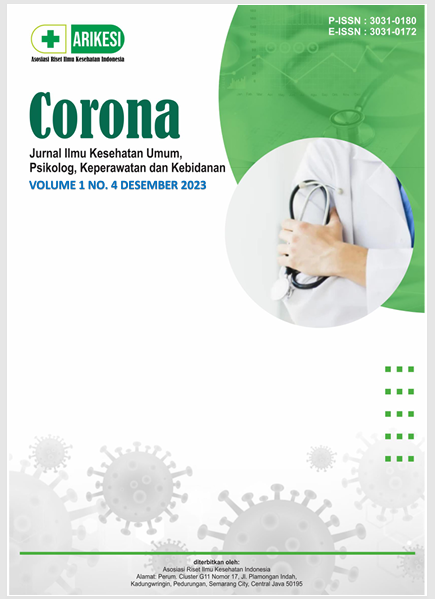Gambaran Kondisi Gangguan Stress Pasca Trauma Pada Perempuan Korban Kekerasan Dalam Hubungan Romantik
DOI:
https://doi.org/10.61132/corona.v1i4.147Keywords:
post traumatic stress disorder, romantic relationships, violenceAbstract
Women have a deeper attachment when in a romantic relationship because they have an orientation towards having a mutually supportive relationship with their partner and gaining love and intimacy (Wiraswati, 2014). Violence against women is prone to causing post-traumatic stress disorder or PTSD. PTSD includes the emergence of unwanted intrusive thoughts, avoiding activities related to the traumatic experience, and exhibiting excessive emotional and physiological reactivity. In this study, interviews were conducted based on the PSSI-5 and mapping of the severity of PTSD symptoms using the Davidson Trauma Scale on three respondents. The research results showed that two respondents showed sub-clinical PTSD symptoms, while one other person showed high PTSD symptoms that interfered with daily activities. All respondents showed the emergence of PTSD symptoms including the emergence of repetitive intrusive thoughts without intention, avoiding stimuli that resemble traumatic events, feeling emotional dullness, and showing increased reactivity.
Downloads
References
American Psychiatric Association. (2013). Diagnostic and statistical manual of mental disorders (5th edition). Arlington, VA: Pengarang
D'Andrea, W., Sharma, R., Zelechoski, A., & Spinazzola, J. (2011). Physical health problems after single trauma exposure: When stress takes root in the body. Journal of the American Psychiatric Nurses Association, 17 (6). 378–392. DOI: 10.1177/1078390311425187
Flemke, K. R., Underwood, J. W., & Allen, K. R. (2014). Childhood abuse and women’s use of intimate partner violence: exploring the role of complex trauma. Partner Abuse, 5 (1). 98-112. http://dx.doi.org/10.1891/1946-6560.5.1.98
Jordan, K. (2001). Working with trauma survivors with PTSD: An overview of assesment, diagnosis, and treatment. Counseling and Human Development, 34 (1). 1-12.
Kastello, J.C., Jacobsen, K.H., Gaffney, K.F., Kodadek, M.P., Bullock, L.C., & Sharps, P.W. (2015). Posttraumatic stress disorder among low-income women exposed to perinatal intimate partner violence. Arch Womens Ment Health. DOI 10.1007/s00737-015-0594-0
Komisi Nasional Perempuan. (2022). Lembar fakta catatan tahunan (catahu) 2021: Peningkatan Jumlah Kasus KBG di Tahun 2021 Menjadi Alarm Untuk RUU TPKS Segera Disahkan. Diakses dari https://komnasperempuan.go.id/kabar-perempuan-detail/peluncuran-catahu-komnas-perempuan-2022
Stampfel, C.C., Chapman D.A., & Alvarez, A.E. (2010). Intimate partner violence and posttraumatic stress disorder amon high-risk women: does pregnancy matter? Violence Against Women 16:426–443
Ullman, S.E. & Filipas, H.H. (2001). Predictors of PTSD Symptom Severity and Social Reactions in Sexual Assault Victims. J Trauma Stress. 14(2): 369–389. doi:10.1023/A:1011125220522
van der Kolk, B. A. (2002). The assessment and treatment of complex PTSD. Dalam R. Yehuda (Ed.), Traumatic stress (hal. 1–29). Washington, DC: American Psychiatric Press.
Wiraswati, A.A., & Supriyadi, S. (2015). Hubungan Antara Harga Diri dengan Pengambilan Keputusan untuk Kawin pada Wanita Bali Usia Dewasa Awal. Jurnal Psikologi Udayana, Vol. 2, No. 1, 13-24. DOI: https://doi.org/10.24843/JPU.2015.v02.i01.p02





